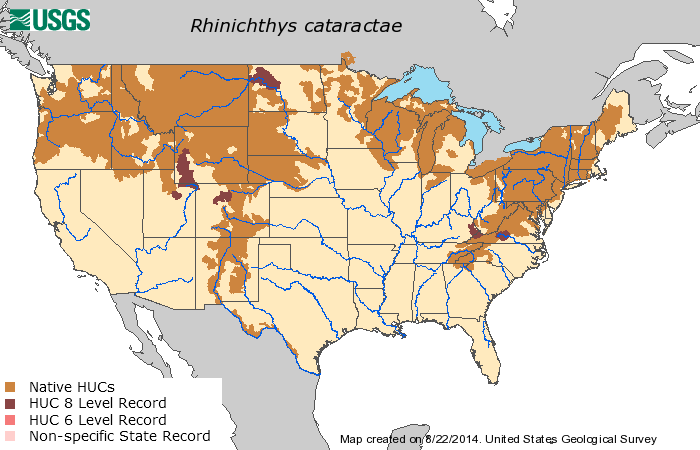Longnose Dace

Scientific Names: Rhinichthys cataractae
Common Names: Longnose Dace
Longnose Dace are streamlined minnows that have an elongated snout, sucker-like mouth and a coloration that ranges from dark brown to light tan. Their shape, as well as small bladders in their bodies make it easy for them to swim and live along the bottom of fast-flowing streams. These characteristics, especially their markings, make them easy to confuse with Blacknose Dace, a related minnow species.
Longnose Dace commonly prefer streams with gravel, cobble or boulder bottoms, but they are also found in lakes and clear river pools. Young specimens of the fish can be seen in shallow areas, while older, more mature ones prefer waters with faster currents and more rock formations.
Longnose Dace are bottom-feeders. They prey on immature blackflies, midges and mayflies, as well as terrestrial insects and fish eggs. Longnose Dace have also been found to eat algae and bottom-dwelling insect larvae. On the whole, they are quite opportunistic feeders.
Longnose Dace Interesting Facts
- Some Longnose Dace have yellow underbellies, though most have white ones;
- they prefer water temperatures cooler than 23 degrees Celsius;
- since Longnose Dace are highly sensitive to sedimentation, their presence can be used as an indicator of stream health;
- and Longnose Dace typically only reach a length of 2 to 3 inches.
Longnose Dace Distribution
Longnose Dace are the most widely distributed minnow species in North America. Inhabiting most of Canada, their range reaches down to the Rocky Mountains, into Mexico and back up through the Appalachian Mountains to the U.S.’ eastern seaboard.
Longnose Dace Biology
A 2014 study from researchers at the University of Calgary found that Longnose Dace are very sensitive to environmental degradation. Scientists observed clear adverse health effects, such as altered sex ratios and hormonal changes, in dace downstream from wastewater treatment plants.
An investigation led by scientists at the University of Nebraska – Lincoln in 2014, published in the journal Ecology of Freshwater Fish, found that Rainbow Trout are somewhat likely to prey on Longnose Dace even if the trout have no prior experience pursuing them as a food source. The researchers, who studied interactions between the two fish for only a few days, concluded more long-term study is needed to determine if Rainbow Trout have significant effects on Longnose Dace survival rates.
The American Society of Civil Engineers published a study in 2012 looking into the effectiveness of different culvert types used to aid the movement of Longnose Dace from one stream to another. Researchers found that culverts that were scaled with the fish’s length had the best passage rates.
References Cited
- https://ohiodnr.gov/static/documents/wildlife/wildlife-management/OH_SWAP_2015.pdf
- http://nas.er.usgs.gov/queries/FactSheet.aspx?speciesID=638
- https://www.dec.ny.gov/animals/94477.html
- http://www.jstor.org/discover/10.2307/1441069?uid=3739840&uid=2&uid=4&uid=3739256&sid=21104700043663
- http://wildlife.ohiodnr.gov/species-and-habitats/species-guide-index/fish/longnose-dace
- https://fieldguide.mt.gov/speciesDetail.aspx?elcode=AFCJB37020
- http://www2.dnr.cornell.edu/cek7/nyfish/Cyprinidae/longnose_dace.html
- http://www2.dnr.cornell.edu/cek7/nyfish/Cyprinidae/longnose_dace_pic.html
- http://theses.ucalgary.ca/handle/11023/1411
Longnose Dace article by Daniel Kelly, Fondriest Environmental, September 2014










